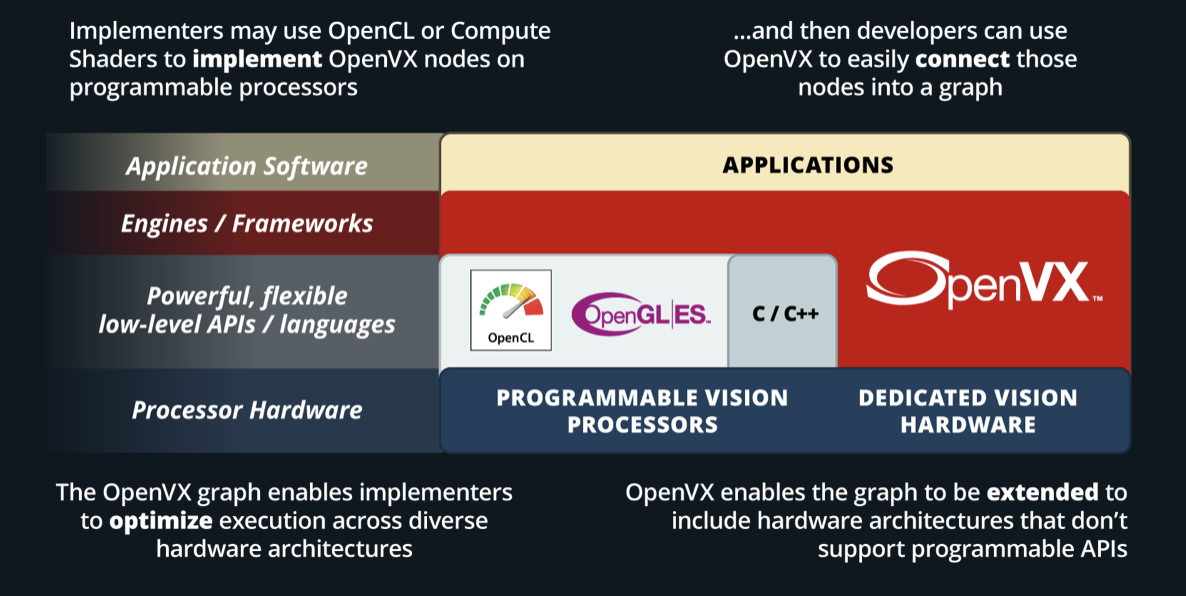AMD OpenVX documentation#
AMD OpenVX is a highly optimized conformant open-source implementation of the Khronos OpenVX Version 1.3 computer vision specification. Khronos OpenVX is an open, royalty-free standard for cross-platform acceleration of computer vision applications. It allows for rapid prototyping as well as fast execution on a wide range of computer hardware, including small embedded AMD64 CPUs and large workstation discrete GPUs. OpenVX enables performance and power-optimized computer vision processing, especially important in embedded and real-time use cases such as face, body and gesture tracking, smart video surveillance, advanced driver assistance systems (ADAS), object and scene reconstruction, augmented reality, visual inspection, robotics and more.

Khronos OpenVX API offers a set of optimized primitives for low-level image processing, computer vision, and neural net operators. The API provides a simple method to write optimized code that is portable across multiple hardware vendors and platforms.
OpenVX allows for resource and execution abstractions, which enable hardware vendors to optimize their implementation for their platform, such as the AMD OpenVX library. Performance portability across CPUs, GPUs, and special-function hardware is one of the design goals of the OpenVX specification.
OpenVX is used to build, verify, and coordinate computer vision and neural network graph executions. The graph abstraction enables OpenVX implementation to optimize execution for the underlying hardware. Using optimized OpenVX conformant implementation, software developers can spend more time on algorithmic innovations without worrying about the performance and portability of their applications.
The standard defines graph conventions and execution semantics to address the needs of the developers. The advantage of the graphical interface is the ability of the underlying conformant implementation to optimize the whole graph pipeline instead of specific functions.
OpenVX specification also defines the VXU or the immediate function library. VXU operators allow developers to use all the OpenVX operators as a directly callable C function without creating a graph first.
Applications built using the VXU library do not benefit from the optimizations enabled by graph execution. The VXU library can be the simplest way to use OpenVX and is the first step in porting existing vision applications.
AMD OpenVX features#
The code is highly optimized for both x86 CPU and OpenCL/HIP for GPU
Supported hardware spans the range from low power embedded APUs, laptops, desktops, and workstation graphics
Supports
Windows,Linux, andmacOSIncludes a
graph optimizerthat looks at the entire processing pipeline and removes/replaces/merges functions to improve performance and minimize bandwidth at runtimeScripting support with RunVX allows for rapid prototyping, without re-compiling at production performance levels
Note
The amd_openvx project includes the AMD OpenVX Library.
Vision conformant feature set implementation#
The Vision conformant feature set includes all the functions and objects in the base feature set, plus the vision data objects and vision functions.
Base feature set#
The purpose is to define a minimal subset of OpenVX features that enable the construction and execution of OpenVX graphs, but does not contain any specific vision-processing operations. The basic framework objects delivered include the following. Refer to Basic framework Objects for more information.
vx_reference
vx_context
vx_graph
vx_kernel
vx_node
vx_parameter
vx_meta_format
vx_delay
Vision conformance feature set#
Provides a basic set of vision processing functions roughly equivalent to the set of functions available in version 1.1 of the OpenVX specification. In addition to the framework objects included in the Base feature set, the Vision conformance feature set includes the following set of data objects that the Vision functions operate upon and produce. Refer to Vision conformant data objects for more information.
Vision conformance data objects#
vx_array
vx_convolution
vx_distribution
vx_image
vx_lut
vx_matrix
vx_pyramid
vx_remap
vx_scalar
vx_threshold
vx_object_array
Vision Conformance Functions#
Specific Vision conformance functions in the feature set include the following:
AMD OpenVX - Extensions#
The OpenVX framework provides an extension mechanism to add new vision functions to OpenVX by 3rd party vendors. As described in AMD OpenVX Extensions, AMD provided extensions include the following:
amd_custom: Custom node extension module
amd_loomsl: Radeon LOOM stitching library for live 360-degree video applications
amd_media: Media extension module for video and JPG encoding and decoding
amd_migraphx: enables importing MIGraphx library into an OpenVX graph for inference
amd_nn: Neural network module built on top of MIOpen library
amd_opencv: OpenCV extension module to access OpenCV functionality as OpenVX kernels
amd_rpp: Extension to access RPP ROCm Performance Primitives (RPP) functionality as OpenVX kernels
amd_winml: Module to access Windows Machine Learning (WinML) functionality as OpenVX kernels
Note
OpenVX and the OpenVX logo are trademarks of the Khronos Group Inc.